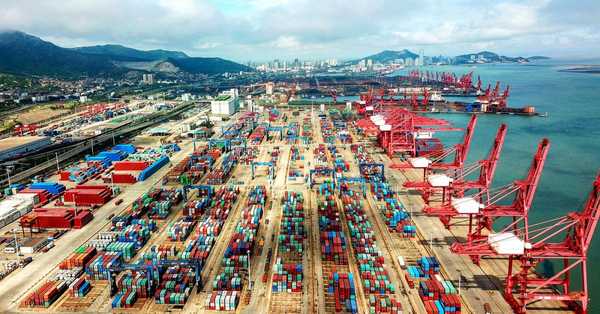China and the US are shipping goods to one another on the briskest tempo in years, making the world’s largest bilateral trade relationship look as if the protracted tariff conflict and pandemic never happened.
Eighteen months after the Trump administration signed the trade deal, the settlement has turned out to be a truce at finest. The US trade deficit hasn’t shrunk, most levies are nonetheless in place, and it hasn’t led to negotiations over different financial points.
And but, bilateral trade in goods is an space of stability in a relationship that has in any other case continued to deteriorate, with rising pressure over Hong Kong, Taiwan, human rights, the origins of the Covid-19 pandemic, accusations of laptop hacking and plenty of different flashpoints.
Monthly two-way trade, which tumbled to $19 billion in February of final yr amid shutdowns in Chinese factories, rebounded over the previous yr to new data, in accordance with official Chinese information. And that increase appears set to proceed, with China buying tens of millions of tons of U.S. farm goods for this yr and subsequent and stuck-at-home US shoppers nonetheless purchasing and importing in document quantities.
While the US authorities’ numbers differ considerably, the bustling trade has defied all expectations that the tariffs on a whole lot of billions of {dollars} price of merchandise would pressure a decoupling of provide chains. Instead, each side have realized to stay with the taxes, with Chinese companies shopping for extra to meet the phrases of the 2020 trade deal, and US firms buying goods they’ll get elsewhere to fulfill elevated family demand fueled partly by trillions of {dollars} in authorities stimulus.
“We’ve seen the strong consumer demand that’s been occurring throughout the pandemic, and we’ve seen the import levels just go through the roof,” stated Jonathan Gold, vp of supply-chains and customs coverage on the National Retail Federation, which represents distributors from mom-and-pop shops by the big-box chain behemoths. “That’s a strong sign that the economy continues to recover.”
Exports from South Korea and Taiwan to the U.S. have additionally risen over the identical interval, underscoring the power of U.S. demand regardless of one of many worst outbreaks of Covid-19 of any nation.
Almost half of the $259 billion in cargo transferring out and in of Los Angeles port the U.S.’s largest includes China and Hong Kong. US demand for goods continues unabated, with document inbound shipments to the port in May as firms begin to restock forward of the Christmas purchasing season.
“All signs point to a robust second half of the year,” Los Angeles port Executive Director Gene Seroka stated throughout a current press briefing, noting that fall trend, back-to-school, Halloween and vacation goods had been already arriving on the docks.
With tariffs in place on greater than $300 billion in imports from China, from footwear and clothes to electronics and bicycles and even pet meals, many US retailers are selecting to soak up the associated fee and squeezing their revenue margins, the NRF’s Gold stated. Some are passing these alongside to shoppers.
Firms are also coping with backlogs and bottlenecks at US ports and elevated delivery prices.
“Between the cost of the tariffs and the increased cost of transportation that we’re seeing, that’s having an impact on companies’ bottom line,” Gold stated. “They’ve seen significant cost increases as a result of both the trade war and the transportation crisis we’re facing.”
The Biden administration hasn’t stated whether or not it plans to proceed with the deal and is reviewing U.S. coverage towards China, however with US Trade Representative Katherine Tai calling the trade relationship “unbalanced” and Treasury Secretary Janet Yellen saying the deal didn’t deal with the elemental issues with China, the outlook is unfavorable.
On high of these tensions, China’s buying targets expire on the finish of the yr, and the nation is properly behind the place it promised it will be now. Those targets had been initially seen as unrealistically excessive and issues just like the Covid-19 pandemic or the grounding of the Boeing 737 Max jet put them even additional out of attain.
With Beijing lacking its buy targets, China refraining from plane purchases and firms transferring automotive manufacturing out of the US to keep away from getting hit with tariffs from the trade conflict, the settlement between the world’s two largest economies is “pretty irrelevant at this stage,” stated Chad Bown, a senior fellow on the Peterson Institute for International Economics, whose newest analysis has targeted on the pact.
“China buys what China needs,” Bown stated. “If it’s shopping for extra of sure American merchandise, it’s doing so in all probability out of its personal curiosity.
US-China goods trade booms as if virus, tariffs never happened. - Published by The Beyond News (Politics).
